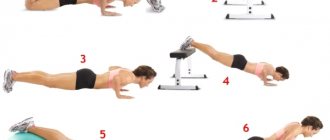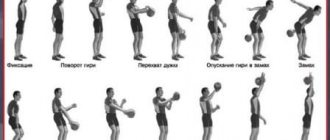GTO standards for the test (test) “Kettlebell snatch 16 kg”
| Stage (age) | Boys/Men | ||
| Bronze | Silver | Gold | |
| V stage (16-17 years old) | 15 | 18 | 33 |
| VI stage (18-24 years old) | 21 | 25 | 43 |
| VI stage (25-29 years old) | 19 | 23 | 40 |
| VII stage (30-34 years) | 19 | 22 | 39 |
| VII stage (35-39 years) | 18 | 21 | 37 |
| VIII stage (40-44 years) | 14 | 17 | 28 |
| VIII stage (45-49 years) | 9 | 11 | 23 |
| IX stage (50-54 years old) | 8 | 10 | 20 |
| IX stage (55-59 years old) | 6 | 8 | 18 |
GTO standards for the test 'Kettlebell Snatch 16 kg' - expand
GTO standards for the test (test) 'Kettlebell snatch 16 kg' - collapse
Kettlebell snatch with one hand: video
https://youtu.be/kwrZeWU6DFE
Record holders in weight lifting
In almost all sports, including kettlebell lifting, there are people who can exceed the established standards. These are unconventional and strong personalities in every sense of the word. They are called record holders. Most often, their achievements are recorded. And they are considered champions until someone breaks their kettlebell lifting record.
Thus, during the double-event competition among men capable of lifting a weight of 32 kg, Johnny Benidze won in 2009. At that time, the necessary standard was to push the sports equipment upward. The first record holder in the weight category up to 60 kg managed to squeeze the weight 110 times. It is noteworthy that in the same year the athlete set another weight record of 32 kg. This time he needed to lift the equipment using a jerk. He managed to do this exactly 164 times.
In 2006, competitions were held between men weighing up to 65 kg. In terms of the number of correct and fast jerks, Roman Mikhalchuk won the victory, lifting the weight exactly 172 times.
In 2008, Nikita Balagov won among seventy-kilogram athletes. This athlete had to jerk the weight 123 times. In 2006, the 75-kilogram athlete Dmitry Komarichev lifted equipment with pushes only 135 times.
Among athletes weighing 80 kg in 2007, Anton Anasenko won. The number of kettlebell jerks he performed during the competition was 163 times.
Rules for performing the exercise
Before starting the exercise, place a weight in front of you between your legs. Feet shoulder width apart.
Swing
Swing the weight between your legs for a subsequent lift. Legs are bent at an angle of 45 degrees. There remains a natural deflection in the lower back; move your non-working arm all the way back.
Detonation
With a sharp movement, pull your shoulder back, your working arm remains straight. Next, push the weight forward and upward with your pelvis, straighten your legs at all joints. To create momentum, lift your heel off the platform.
Podsed
Lower your heel to the floor, perform a squat, with your arm fully straightened at the elbow joint
Fixation
Straighten your legs at all joints
Reset
Lean your body back slightly to minimize the stress on your back during the release. Bend your arm and return back into the swing.
Repeat the exercise as many times as necessary. You can see the detailed technique for performing the exercise in the following video.
Historical information about the rules
Initially, the rules for kettlebell lifting dealt with triathlon. Athletes competed in only three categories: clean and jerk, snatch and press. During the competition, the total duration of one such exercise was only 1-1.5 minutes. At that time it was difficult to talk about a record. The kettlebell press was not perfect for many athletes. Consequently, there have not yet been huge achievements in this sport.
When more stringent changes were made to the rules, the number of effective performances increased threefold. So, during the next competition at the beginning of 1973, which took place in Yaroslavl, athlete A. Vorontsov managed to squeeze a two-pound weight as many as 123 times. By the way, the record bench press at that time was considered to be 42 times.
Later, when adjusting the rules, it was necessary to think about the timing of the exercise. After the secondary change, it reached 40-50 minutes. When the competition time was shortened, the kettlebell snatch had to be sacrificed. The record in this case became real. The number of people wishing to install it has also increased.
Description of the exercise
The kettlebell snatch is a basic competitive exercise, common not only in kettlebell lifting, but also in CrossFit. The exercise develops endurance and explosive strength. With the correct technique, your shoulders will become more powerful and strong. The kettlebell snatch is a universal exercise and is suitable for both men and women.
The movement is performed primarily by the back and deltoid muscles during the lift. It is important not to overdo the undermining as this can cause you to lose your balance.
Why do the exercise?
The 16 kg kettlebell snatch (pudovki) is included in the list of tests for passing the GTO standards. The technique of performing the exercise in this case remains unchanged. The athlete continuously performs the exercise for 4 minutes, and the judges count the number of repetitions. In particular, to receive a gold GTO badge, a man under 40 years old must snatch a 16 kg projectile 40 times.
Kettlebell lifting began to appear in the 50s of the last century, and has now gained great popularity.
In order to cleanly perform a kettlebell snatch, an athlete must have physical strength, flexibility and the ability to accurately coordinate movements. What muscles work during a snatch? This exercise involves almost all muscle groups and requires enormous physical and energy output. Kettlebell lifting is a powerful tool for developing general physical fitness, strength and coordination.
Including the snatch exercise in your training program leads to the following positive effects:
- Development of strength and growth of the muscles of the back, legs and other muscle groups.
- Strengthen your hands and increase your grip strength.
- Increasing strength endurance and functional capabilities of the body, mastering breathing techniques.
- Training of motor coordination and the ability to tense and relax muscles under control.
- Development of speed indicators.
It is better to start mastering the kettlebell snatch by practicing its component movements. The technique is honed with a minimum weight of 16 kg, and then the weight of the projectile increases. For girls, even 16 kg may be too much weight, so it is worth saying that many fitness clubs have special equipment for women weighing less than 10 kg.
For girls, a 16 kg weight may be too heavy, so it is recommended to use lighter weights.
You can also use regular deadlifts and military presses as preparatory exercises.
Kettlebell lifting involves various variations of exercises. The competitive version of the snatch involves lifting a weight in a standing position with one hand, throwing the apparatus and performing the movement with the other hand without interruption. The same technique is used when passing the GTO standards.
16 kg weights are used when passing the GTO standards.
The starting position may vary: the weight can be placed in the middle in front of the athlete or behind one of the legs. You can also perform jerks while sitting in order to eliminate the work of the leg muscles for one reason or another. And finally, a snatch of two weights can be performed simultaneously or alternately.
Tips for Performing the One-Arm Kettlebell Snatch
- It is necessary to control the kettlebell during the entire exercise so that it does not hit your hand at the top point; the impact is eliminated by turning the wrist almost at the highest point
- Keep the kettlebell close to your body so it's always under control and you'll spend less effort swinging and releasing it.
- Concentrate on lifting the weight not through your arm muscles, but through your pelvis, so you can do more repetitions.
Let's look at the world records for women's one-arm kettlebell snatch.
Snatch - women (weight 24 kg)
| Weight category | Result | Record holder | Year |
| 58 | 201 | Yaremenko Olga | 2016 |
| 63 | 193 | Dedyukhina Ksenia | 2013 |
| 68 | 200 | Dedyukhina Ksenia | 2014 |
| 68+ | 190 | Anastasia Zolotareva | 2016 |
Historical information about the sports equipment
The kettlebell, as a sports equipment, was known at the end of the 17th century. At that time, it was used not only to develop physical strength and endurance, but was also used during circus performances to entertain the public.
In October 1948, the first competitions were organized, during which participants lifted two-pound weights. Despite the fact that there were no rules as such, such competitions became the norm. They began to be held more and more often. And even later, weight lifting grew into a separate sport.
The first official rules for this sport were created in 1962. And since 1970, weightlifting competitions began to be held annually. Moreover, these rules changed regularly. They were made simpler. And all in order to attract as many athletes as possible to this sport.
Kettlebell lifting received its official recognition in early 1985. And exactly a couple of years later, even the All-Union Organization of Kettlebell Lifting was organized in the USSR. True, this organization did not last long. It was dissolved in the fall and a new one was created, which was called the International Kettlebell Lifting Federation. After some time, this sport took root. Later, many athletes began to set their records with weights.
Alternative Substitutes for the One-Arm Kettlebell Snatch
One of these exercises is the Kettlebell Swing with two hands - this is an exercise that came to CrossFit from kettlebell lifting. The exercise strengthens the muscles of the thighs, is aimed at developing strength and endurance, it is considered easy to perform and strengthens the entire shoulder core.
Swing kettlebells with two hands
Handstand push-ups are also an exercise that focuses on the deltoids. When performing these push-ups, you lift 100 percent of your body weight.
Strict handstand push-ups
The two kettlebell snatch is a similar exercise, but more technically complex because it uses both arms. We advise you to learn the kettlebell snatch with one hand, and then start snatching two kettlebells.
Snatch of two weights
Auxiliary exercises
Let's look at a few exercises to do before you begin the one-arm kettlebell snatch.
Russian Kettlebell Swings The kettlebell swing is a powerful exercise that develops explosive strength and strengthens the muscles of the hips, back and buttocks. It is considered a guide, as it helps to develop the correct technique for moving the pelvis during the swing and lift.
Russian kettlebell swings
Army barbell standing press. This exercise is aimed at working the muscles of the shoulder body, as well as developing coordination. These aspects are essential when performing the kettlebell snatch.
Standing barbell press (military)
The kettlebell snatch is a competitive exercise in kettlebell lifting. The following are tables of grade standards for men and women for 2018-2021.
TABLE OF DIFFERENT STANDARDS FOR MEN:
1. Double event (the number of points scored in 10 minutes in each exercise) * points are awarded: for 1 kettlebell push - 1 point, for 1 kettlebell jerk - 0.5 points
| Weight category (kilogram) | MSMK kettlebell 32kg | MS kettlebell 32kg | KMS kettlebell 32kg | I weight 24kg | II kettlebell 24kg | III kettlebell 24kg | I(u) kettlebell 16kg | II(u) kettlebell 16kg | III(u) kettlebell 16kg |
| 48 | — | — | — | — | — | — | 110 | 75 | 50 |
| 53 | — | — | — | — | — | — | 120 | 85 | 55 |
| 58 | — | — | — | 90 | 70 | 50 | 130 | 95 | 60 |
| 63 | 192 | 126 | 75 | 100 | 80 | 60 | 140 | 105 | 65 |
| 68 | 210 | 146 | 83 | 110 | 90 | 65 | 150 | 110 | 70 |
| 73 | 222 | 162 | 95 | 120 | 95 | 70 | 160 | 120 | 75 |
| 73+ | — | — | — | — | — | — | 170 | 125 | 80 |
| 78 | — | — | — | 130 | 105 | 80 | — | — | — |
| 85 | 234 | 178 | 117 | 140 | 110 | 85 | — | — | — |
| 85+ | 246 | 190 | 126 | 160 | 130 | 100 | — | — | — |
TABLE OF DIFFERENT STANDARDS FOR WOMEN:
2. Snatch (number of weight lifts in 10 minutes)
| Weight category (kilogram) | MSMK kettlebell 24kg | MS kettlebell 24kg | KMS kettlebell 24kg | I weight 16kg | II kettlebell 16kg | III kettlebell 16kg | I(u) kettlebell 16kg | II(u) kettlebell 16kg | III(u) kettlebell 16kg |
| 48 | — | — | — | 80 | 60 | 45 | 43 | 33 | 23 |
| 53 | — | — | — | 90 | 70 | 50 | 45 | 35 | 25 |
| 58 | — | — | — | 100 | 80 | 60 | 55 | 45 | 35 |
| 63 | 159 | 126 | 73 | 110 | 90 | 70 | 65 | 55 | 45 |
| 63+ | 181 | 146 | 86 | 125 | 100 | 85 | 75 | 65 | 55 |
In the GTO standards, you can also find a one-handed kettlebell snatch for men. The following are the gold, silver and bronze medal standards for different ages.
| Bronze | Silver | Gold | |
| from 18 to 24 years old | 21 | 25 | 43 |
| from 25 to 29 years old | 19 | 23 | 40 |
| from 30 to 34 years old | 19 | 22 | 39 |
| from 35 to 39 years old | 18 | 21 | 37 |
| from 40 to 44 years old | 14 | 17 | 28 |
| from 45 to 49 years old | 9 | 11 | 23 |
| from 50 to 54 years old | 8 | 10 | 20 |
| from 55 to 59 years old | 6 | 8 | 18 |
Kettlebell Fitness
Author: Jeff Neupert
In the Kettlebell Lifting Association RKC (Russian Kettlebell Challenge), the kettlebell press exercise is the standard measurement of upper body strength. In order to reach the second level, a man must be able to press a kettlebell with one hand, which in weight will be ½ of his own weight, a woman needs to lift a quarter of her weight.
It looks intimidating to some, but it's actually easy if you know how to do it.
When Bob Hoffman was the coach of the US weightlifting team, he was asked what he needed to do to improve his performance in the barbell squat. Bob Hoffman replied, “Squat.” What a simple and at the same time wise answer. This opinion coincides with the principles of our RKC association regarding strength training. In order to improve your bench press performance, you need to bench press more. Unlike barbell squats, you can and should do a lot of bench presses. The reason is simple - the “kettlebell press” exercise puts less strain on the nervous system and therefore can be performed much more often.
Three ways to improve your kettlebell press performance.
There are three main approaches to increasing performance in the kettlebell press exercise.
These include:
1. Low volume with high execution frequency. 2. Average volume with average execution frequency. 3. High volume with low execution frequency.
Let's look at these methods in more detail.
Approach #1 . Low volume, high execution frequency.
This technique in training is called “warm-up”. During training you will need to perform a small number of repetitions, usually from 4 to 10, the number of training sessions per week will be from 3 to 6 times. The intensity of the load can be described as “moderate”. For this method, it is necessary to use a kettlebell weight equal to 60-80% of the maximum.
Approach #2 . Average volume with average execution frequency.
The number of repetitions performed will increase from 15 to 50 times in one approach. How many times you can perform the exercise depends on your physical fitness. Training at this load is carried out 2-3 times a week. In such cases, the “load rotation principle” is applied. Each workout should be carried out with a different load on the muscles being trained: it is necessary to alternate the load each workout - perform a smaller volume on one, and a larger volume on the other. For this method, it is necessary to use a kettlebell weight equal to 70-90% of the maximum.
Approach #3 . High volume with low execution frequency.
This method in powerlifting and bodybuilding was developed in 1980, and was perfect for many athletes, including me. This training method allows you to gain strength and increase muscle mass. You only need to do the bench press once a week. You can determine for yourself the number of times in one approach, but this number should be high from 20 to 75 times. Kettlebell weight - 60-90% of the maximum. The duration of training with such a load should be 12 weeks or more, during which it is necessary to gradually increase the weight of the kettlebell.
Which of the above methods suits you best?
It depends on you, on your endurance and on how much time you are going to spend on training. In fact, I suggest using all of these approaches in one order or another. Here are three possible combinations:
1. Method 1, Method 3, Method 2 2. Method 3, Method 2, Method 1 3. Method 2, Method 3, Method 1
Remember, the body adapts very well to the load if you alternate it correctly. According to Russian sports scientist Professor Arkady Vorobyov, the more varied the load in your training program, the better for your muscles. However, we should not forget that the more difficult the training becomes, the more likely it is that something can go wrong.
Jeff Newport, RKC,CSCS Certified Instructor, has been working in the fitness industry as a personal trainer since 1993. He is a former professional weightlifter and winner of numerous competitions for his country. Since January 2002, he has been involved in kettlebell lifting - training himself and training his clients. For more information on strength training, visit Jeff Neupert's blog at www.chasingstrength.com or www.kettlebellsecrets.com.
Training complex
Let's look at 2 complexes using a kettlebell push with one hand. This exercise is not used in CrossFit in its pure form. A dumbbell acts as a projectile. All CrossFit complexes are aimed at developing endurance and explosive strength, and this is exactly what is needed for an athlete who wants to succeed in kettlebell lifting.
Complex 1
Objective: Complete 10 rounds.
10 dumbbell snatches with each arm 10 push-ups 5 squats with each leg 10 burpees.
Complex 2
Objective: complete 3 rounds.
Perform 50 dumbbell snatches with one arm (25 each)
Alternative Exercises
The push press is one of the most popular CrossFit strength exercises. It is one of the basic weightlifting exercises that works large muscle groups and also develops coordination and flexibility.
Press press
Military kettlebell press with two hands. The military press is one of the best exercises for the entire shoulder core, and the kettlebell, as an unusual apparatus, helps develop coordination of movements.
Military two-hand kettlebell press
Clean and push. To perform this exercise you will need a barbell. The exercise is complex and quite difficult. Lift the barbell off the floor through a squat. When the bar reaches your knees, quickly lift the barbell toward your chest. The bar rests on the front of the shoulders. Straighten up completely and, as you exhale, press the barbell overhead.
Clean and jerk
Auxiliary exercises
Lifting the weights onto the chest with a swing. The exercise is a component of the long cycle push of the kettlebell, and also serves as a leading exercise to the exercise in question. It is aimed at developing the muscles of the shoulder body.
Raising weights to the chest with a swing
The one-arm kettlebell snatch is also an auxiliary exercise for TDC. Volumetrically works the rectus dorsi muscles for casting; the hand is most intensively loaded for the same. Something like “aerobic exercise” during the development of general endurance for a long cycle push.










